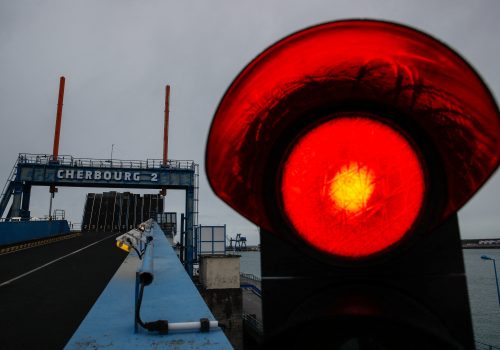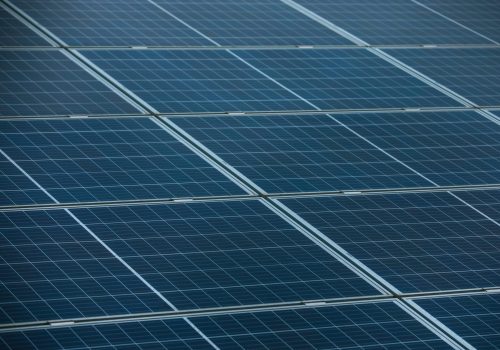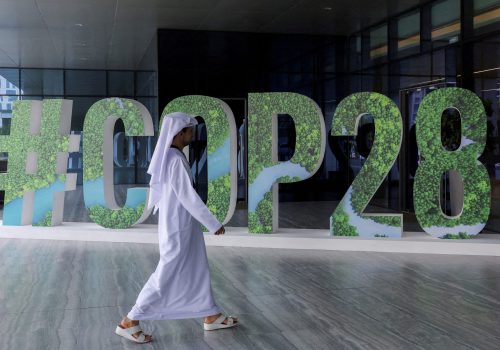Even as Brexit awkwardness remains, the UK and EU should work together on decarbonization
The end of this month will mark four years since the United Kingdom left the European Union (EU). Despite Brexit and continued disagreements regarding the status of Northern Ireland and border security around the English Channel, relations between the EU and Britain have warmed since the winter of 2020. In fact, there is increasing convergence today between the EU and the United Kingdom on key policy areas, especially climate action and decarbonization. More cooperation is needed, however. While the EU proceeds to increase its share of renewable energy sources in its energy mix under the European Green Deal and REPowerEU Plan, it should also continue to coordinate with the United Kingdom on decarbonization.
As the EU maneuvers toward a leading role in climate action and decarbonization, an EU-UK partnership based on accelerating the clean energy transition would be a logical step forward for their relations. This is especially needed as the United Kingdom has recently made several worrying U-turns on carbon emission reduction goals, including postponing the deadline for selling new gas and diesel cars and delaying the phaseout of gas boilers. At the same time, the EU has begun wavering on its own objectives, including on its previously made pledge to increase its greenhouse gas reduction goal beyond 55 percent below 1990 emission levels.
To keep the energy transition on track, a UK-EU partnership should focus on four areas: growing energy infrastructure connections between the United Kingdom and EU, aligning carbon pricing policies, the EU inviting Britain to join the EU-led Critical Raw Materials Club, and developing means of safeguarding against worker exploitation by critical mineral exporters.
Leaders and high-level officials have consistently expressed interest in alignment between the United Kingdom and EU on climate action. During his 2023 state visit to Paris, for example, King Charles III proposed to French President Emmanuel Macron a British-French “sustainability entente” as a means of strengthening UK-France relations. Shortly after, Germany and the United Kingdom announced that they were in preliminary talks to construct a four-hundred-mile hydrogen pipeline under the North Sea. The purpose of the pipeline would be for “green hydrogen” generated from UK offshore wind farms to enter Germany’s energy supply mix. The project is ambitious, estimated to cost a staggering twenty billion euros and be completed by 2032, and the amount of power generated by UK offshore wind farms would need to increase significantly to both decarbonize the UK power sector and export green hydrogen.
These UK-France and UK-Germany proposals are still in their early stages, but there is still greater potential for EU-UK cooperation on renewable energy development and adoption. The concept of the sustainability entente with the United Kingdom should be broadened to encompass the entirety of the EU, and it should form the basis of a decarbonization-based alliance.
Growing connections
To begin with, Britain and the EU should aim to further connect their renewable energy infrastructure. This is partly because the United Kingdom has made impressive strides toward transitioning to renewable sources of energy, even though it still remains overly reliant on fossil fuels. The UK Department for Energy Security and Net Zero reported that 41.5 percent of electricity generated in Britain in 2022 came from renewable energy sources, with wind-based energy alone composing an impressive 24.7 percent of the country’s total energy supply. Meanwhile, 22.5 percent of electricity consumed in the EU across the bloc in the same time period came from renewable sources. This is not to say that the transition to renewable energy sources has been even across the EU, though, as member states like Sweden, Latvia, and Finland already boast higher percentages of renewable energy in their electricity supplies compared to Britain. Regardless, the United Kingdom could increase the amount of renewable energy going into the EU energy mix, while adopting technologies and expertise from leading decarbonizing states, such as Sweden, Latvia, and Finland, to accelerate Britain’s own clean energy transition.
Aligning pricing
For UK renewable energy exports to the EU to occur on a wider scale, it will be essential for the EU and United Kingdom to align on carbon pricing mechanisms. The carbon border adjustment mechanism (CBAM), which would levy taxes on imports linked to significant carbon emissions from 2026, is ironically poised to hinder the operation of UK-based renewable energy because it is designed to levy taxes based on the carbon-intensity of the importing country’s entire electricity grid if their carbon pricing does not match the EU’s. Hence, a decarbonization partnership needs to set the terms for the reduction of CBAM tariffs on UK renewable energy sources to both grow their exports to the EU and to encourage the United Kingdom to increase its supply of renewable energy.
Joining the club
Additionally, the EU is in the process of establishing the Critical Raw Materials Club, an EU-led group that would enable members to secure minerals critical for renewable energy technologies. The EU has already invited several allies to become founding members, including the United States, but not Britain. While the United Kingdom has already noted that critical minerals are of strategic value, has partnered with Japan on critical mineral supply chains, and has declared its intent to negotiate a similar agreement with the United States, it has not openly worked to bolster critical mineral supply chain resilience with the EU. This is a mistake, as Britain may find itself beginning to compete with the EU for critical minerals. The United Kingdom joining the Critical Raw Materials Club would reduce the possibility of competition, and it would become another avenue for Britain to strengthen the resiliency of the country’s critical mineral supply chains.
Safeguarding against exploitation
The EU and United Kingdom are likewise in a strong position to jointly promote workers’ rights with critical minerals exporters. Some, but not all, critical minerals exporters, such as the Democratic Republic of the Congo, employ child and slave labor in their mines. For critical raw material exporters that use forced labor, the EU and the United Kingdom must discourage these practices, and both already have legal mechanisms that could hold exploiters accountable. They should employ “Magnitsky” sanctions, but only in a targeted way against some of the worst offenders. That is because an overzealous enforcement-based approach risks pushing such regimes toward China, which is already looking to cement its existing dominance of global critical mineral supplies.
Along with the stick of sanctions, the EU and United Kingdom could also offer carrots to encourage better standards for workers in critical mineral mines, such as offering to partially sponsor the development of local critical mineral refineries in these states. Yet, the EU should not expect that the United Kingdom will implement such policies through a resurrected UK Department for International Development, which was merged into the Foreign Office in 2020. (Even though the Labour Party has made earlier pledges to separate the department again, Labour Party insiders believe it is now unlikely.)
While there remains some hesitation between Brussels and London on coordination due to lingering issues over Brexit, the need for decisive steps toward decarbonization grows as the climate crisis escalates. The EU and United Kingdom must work together on the net-zero transition because there remains a great deal of potential in decarbonization cooperation.
Francis Shin is a research assistant in the Atlantic Council’s Europe Center.
Further reading
Fri, Dec 15, 2023
The EU needs a buyers’ club for critical minerals. Here’s why.
New Atlanticist By Nicole Lawler, Francis Shin
The EU should invite allies and partners to participate in what would primarily be a buyers’ cartel that would pool investment and facilitate coordination of market behavior among members.
Wed, Sep 6, 2023
Policy memo: A NATO-style spending target could fund long-term decarbonization
In-Depth Research & Reports By Ben Judah, Francis Shin, Rachel Rizzo, Théophile Pouget-Abadie
EU member states and like-minded allies should set national-level spending targets, each based on a percentage of their respective annual GDPs, for decarbonization-related purposes. This would provide the basis of an international coalition that would ramp up global climate spending and set a useful benchmark to anchor high-level diplomatic discussions on the subject.
Thu, Nov 30, 2023
Expert analysis: The successes and shortcomings in the fight against climate change at COP28
New Atlanticist By
Our experts dispatched to Dubai, where they analyzed how global leaders responded to the greatest challenges posed by climate change.
Image: RWE's Gwynt y Mor, the world's second largest offshore wind farm located eight miles offshore in Liverpool Bay, off the coast of North Wales. Tuesday July 26, 2022.


